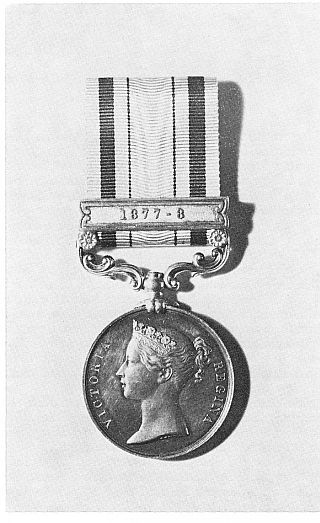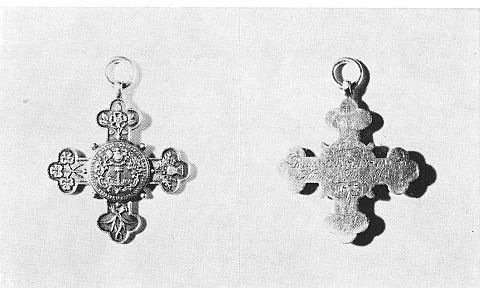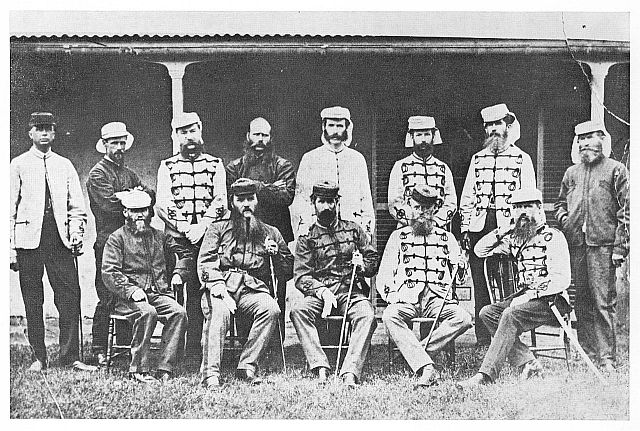
 The South African
The South African
Military History Society
Die Suid-Afrikaanse Krygshistoriese Vereniging
Military History Journal
Vol 2 No 6 - December 1973
Sansom’s Horse
by DR. F. K. MITCHELL, JCD,
Fellow of the S.A. Numismatic Society
Nothing in the whole field of South African military
medal collecting is more fun than tracking down the story
of the units whose titles one finds engraved on the medal’s
rim. This is especially true of our earlier campaign medals,
which often provide almost the only tangible evidence that
some tiny unit ever existed at all.
In a quarter of a century of medal collecting I have been
particularly fascinated by the medal for SOUTH AFRICA
1877-79. This medal was given for service in the Gaika-Gcaleka
War, the Northern Border War, at Morosi’s
Mountain in Basutoland, against Sekukuni, or in the Zulu
War of 1879. More than 200 different South African
volunteer units qualified for it. The very names of some of these
units breathe romance, and conjure up mental pictures of
hardy pioneers on our frontiers, men in the main of British
stock, who lived no less by the horse and the gun than did
their Boer neighbours to the north. Look at the names of
some of these units:
Adelaide Volunteer Cavalry; Barkly Rangers; Berlin
Volunteers; Bettington’s Horse; Colesberg Light Horse;
Murray’s Orange Rovers; Natal Hussars; Kingwilliamstown
Veteran Volunteers; One Star Diamond Contingent;
Sidbury Mounted Rangers; Stutterheim Light Infantry
Volunteers; Southey’s Rangers; Bowker’s Rovers;
Stevenson’s Horse; Lydenberg Rifles; New England Contingent;
Wodehouse True Blues.
Do you blame me for being fascinated?
One of the many gaps in my knowledge was happily
filled by Major Justin Hulme, who told us the story, in the
December 1972 issue of this Journal (Vol. 2. No. 4. The
Editor’s Letter-Box) of ‘Carbutt’s Border Rangers’. I have
the medal awarded to Trooper H. Brunner of that unit. Like
Capt Carbutt’s, this medal has no bar, so I know that
Brunner was mobilised in Natal during the Zulu War of
1879, but that he did not cross the Tugela into Zululand.
(If he had, he would have qualified for the “1879” bar).
Another unit of which details have eluded me over the
years, has been Sansom’s Horse. Now I have never actually
seen a medal named to Sansom’s Horse, but I have been on
the look-out for one, because Tylden in his ‘The Armed
Forces of South Africa’ lists it. His entry is brief in the
extreme:
‘465 SANSOM’S HORSE. A small Kingwilliamstown unit,
served in the Ninth Kaflir War (Medal Roll).’
For years I have had the unanswered question in my
mind. Who was Sansom, of Sansom’s Horse? Was a medal
ever issued to Sansorn’s Horse?
Some months ago, an unusually determined and personable
young man talked his way past my secretary and into
my office, without an appointment, on a particularly busy
morning. We talked briefly and to the point, about the
business of the firm he represented. Then, as I stood up to
usher him out, the penny dropped! ‘Did you say’ I asked,
‘that your name is Sansom?’ ‘That’s right, Doctor, Brian
Sansom’. ‘An unusual name’, I said ‘are you perhaps a
descendant of Sansom, of Sansom’s Horse?’ ‘I am indeed.
He was my great-grandfather! We have a beautiful clock
at home given to him after the Battle of the Springs’. Need
I say that I found time to talk to him a little longer?
Following this chance contact, I subsequently met Brian’s
father, Mr Doug Sansom, of Komgha. With the help of his
friend, the late Dr A. W. Burton, the well-known Border
historian, Doug Sansom had delved into the history of his
forebears. This is their story as he has told it to me:
George Sansom and his wife, Dorothy, were 1820 settlers.
They were members of Calton’s party from Nottinghamshire,
which settled originally near Bathurst. Their son James was
born in 1828 and, as a young man, saw service in the
Frontier wars of 1846 and 185 1-53. After the former war it
was decided to settle the area which became known as
British Kaffraria, between the Keiskamma and the Kei
Rivers, and James Sansom, in common with many of the
young men who had rallied to the colours, was rewarded
by the grant of a farm in the new territory. He thus became
the owner of the farm Hopewell, on the Tyityaba River, nine
miles from the present town of Komgha.
A condition attaching to the grant of these farms and
actually written into the title deeds of Hopewell when
ownership was registered in 1864 was that all able-bodied
men were required to hold themselves in readiness to defend
the nearby Frontier in the event of war.
James Sansom evidently accepted the responsibility of
leadership in this matter, and formed his own volunteer
detachment which became known as Sansom’s Horse and
met once a month for target practice. In due course his son,
Edward Floyd Sansom, was enrolled as a private in his
father’s unit.
In September 1877 fighting erupted on the frontier the
Gaika-Gcaleka or Ninth Kaffir War. The Cape Colonial
Government, which had formally incorporated British
Kaffraria as part of the Colony in 1866, sent detachments of
the Frontier Armed and Mounted Police, and of certain
Colonial volunteer units, into the southern part of the
Transkei, but no imperial troops were permitted to cross
the Great Kei river.
On the 9th of October, 1877, a force consisting mainly of
Sansom’s Horse was encamped at Springs, about six miles
on the Transkei side of the Great Kei, south-east of the
present Kei Bridge. Early that morning, while most of the
men were still asleep, the camp was heavily attacked by a
large force of Gcalekas. Captain Sansom ordered his men
to stand fast, and immediately sent a despatch rider for
reinforcements. Some of the young recruits were close to
panic, but Sansom rallied them — he in fact threatened to
shoot the first man to put his foot in a stirrup! and coolly
set about arranging the defence of the camp. The battle
continued until after midday, but by the time reinforcements
arrived the Gcalekas had withdrawn, leaving many dead
behind them. Sansom’s Horse had two men wounded.
Subsequently the Cape Colonial forces under Commandant
C. D. Griffith drove Kreli and the Gcalekas over the Bashee
River into Bomvanaland. The Cape Government thereupon
came to the mistaken conclusion that the war was over, and
all the volunteers including Sansom’s Horse— were allowed
to return to their homes before Christmas 1877.
According to the late Dr Burton, ‘The Kaffrarian Watchman’
(Kingwilliamstown), of about April 17th 1878, contained
the following report:
“PRESENTATION TO COMMANDANT J. H. SANSOM:
“The gift and an address were presented by Commandant
Charles Duncan Griffith CMG. Battle of the Springs and
Manzana Heights when Commandant Sansom was in command
of ‘Sansom Horse’ as a separate corps in the field.
‘The handsome clock set was presented by ‘OUR Boys’ in
admiration of his conduct, display of cool bravery and
skilful leadership.
‘He was assisted in this battle by Commandant George
Gray whose father was killed by rebel Hottentots in the war
of 1850/53.’
The presentation consisted of an ornate and handsome
clock, with matching side ornaments, in gilt and blue
enamel. The clock itself bears a silver plate on which is the
inscription:
‘Presented to Capt James Sansom
by Our Boys
In admiration of his conduct while serving
in the field. November 1877’
On one side the ornament is inscribed ‘SPRINGS’, and on
the other ‘OCTOBER 1877’.
This was an interesting story, but my original question
was still unanswered. Was a medal ever issued bearing on
its rim the name “SANSOM’s HORSE”? So I asked the obvious
question: ‘Where is Capt James Sansom’s medal?’ Doug
Sansom told me he had never seen it but, following my
enquiry, he found his own father’s medal — awarded to
‘CORPL. E. L. SANSOM’, son of James, who had served in the
unit commanded by his father. It is the South African
Medal, 1877-79, with bar ‘1877-8’, but the unit shown on
the rim is ‘KAFFRARIAN VOLS.’ With it is an ornate
cross-shaped silver medallion, no doubt a shooting prize, bearing
on the obverse the arms of British Kaffraria, and beautifully
engraved on the plain reverse ‘PRIVATE E. F. SANSOM,
Komgha Troop, K.V., 1875.’

South African Medal 1877-79 with bar 1877-78 inscribed
CORPL.E.L.SANSOM, KAFFRARIAN VOLs

Shooting medal with the inscription
VICTORIA DEI GRATIA BRITANNIA R*
REG.F.D.BRITISH KAFFRARIA
on the obverse and engraved on the reverse,
Private E.F.SANSOM Komgha Troop K.V. 1875
Did these two medals hold the clue? I went back to
Tylden’s ‘The Armed Forces of South Africa’ and under
No. 252, as corrected by his ‘Further Addenda and
Corrigenda’, found the following:
‘252. Kaffrarian Rifle Volunteers, but described in the
Comdt-Gen’s Papers (D.D. 1/9) as the Kaffrarian Volunteers.
Apparently not gazetted until 1871. This important
unit consisted of two weak companies of infantry raised at
Kingwilliamstown and of three mounted troops raised
respectively at Komgha, Gonubie and Maclean. The
corps did garrison duty in the Zulu War after serving in
the 9th Kaffir War. In 1878 besides the Commanding
Officer, Comdt Lonsdale, there was a Capt, a Lt and a
Second Lt to each of the two companies and three
troops.’
Suspicion that Sansom’s Horse was in fact the Komgha
Troop of the Kaffrarian Volunteers grew to near certainty,
when Mr Doug Sansom showed me an old photograph of
13 men in uniform, identified in a document signed by the
late Dr Burton, as officers of sections of the Kaffrarian
Volunteers. Here was Capt Sansom himself, together with
Capt James Faunce Lonsdale formerly of the Inniskilling
Fusiliers, the officer commanding and 11 other Captains of
the Artillery, Infantry and Mounted sections.
The accompanying photograph, with identification and
personal details supplied by Dr Burton, provides not only
an interesting portrait gallery of a number of men whose
names are written large in Border history, but gives us a
vivid impression of the uniforms they wore almost a century
ago.

Standing (from the left): Capt F.W. Schermbrucker (Infantry Section)
later Colonel and Commandant of the Eastern Amatola Division at Stutterheim;
Capt W. Warren (Mounted Section). Dark uniform Jacket. Overalls have a
dark stripe down the seams;
Capt Cole (Infantry Section). Black braided white tunic;
Capt George Gray (Mounted Section);
Lieut E.J.Byrne (Infantry
Section). Was an Attorney in Kingwilliamstown;
Capt Richard Walker (Infantry Section). Became first Mayor of East London;
Capt Broster (Infantry Section) Kingwilliamstown;
Capt John Cowie (Mounted Section ) of Fort Warden Farm Komgha. Led Komgha Volunteers.
Seated (from the left): Capt J.Sansom (Mounted Section) of Hopewell, Komgha District.
Gained honours in the Battle of the Springs;
Capt L. Giddy (Artillery Section);
Capt Joseph Walker (Artillery Section); Capt James Faunce
Lonsdale (Infantry Section).
Formerly in the 27th Regiment Inniskilling Fisiliers;
Surgeon Capt Charles James Egan (Dr) of Kingwilliamstown (Infantry Section)
My search must go on. It is a fair assumption that
Sansom’s Horse and the Komgha Troop of the Kaffrarian
Volunteers were one and the same unit. But even if they
were, it is by no means impossible that the medals given to
some members of the unit were actually named to ‘SANSOM’S
HORSE’, and I must try to find one. In the meantime I am
delighted to have hanging, side by side in my wall-cabinet,
the South Africa Medal bar 1877-8, and the silver cross for
shooting, awarded to Corpl Edward Floyd Sansom, of the
Komgha Troop, Kaffrarian Volunteers.
NOTES:
1. KAFFRARIAN VOLUNTEER CORPS. Date of formation 8.2.1872.
Title changed to “Kaffrarian Mounted Rifles” on 31.5.1883. Disbanded 14.9.1892.
2. KAFFRARIAN VOLUNTEER ARTILLERY. Date of formation
26.11.1876. It was distinct from the East London Artillery also called
Kaffrarian Volunteer Artillery. Disbanded 28.4.1885.
3. KING WILLIAM’S TOWN VETERAN VOLUNTEER CORPS.
Date of formation 5.12.1876. Title changed to “King William’s Town
Rifle Volunteers” 21.9.1880. Disbanded 1.11.1885.
4. KING WILLIAM’S TOWN VOLUNTEER ARTILLERY. Date
of formation 4.7.1877. Served in the Ninth Kaffir War 1877/78 — The
Fingo/Gcaleka War and Gaika Rebellion — “Ncayechibi War” on
both sides of the Neiba (Great Kei) River and came to be known as
“Our Boys” or the “Settlers’ Sons”. Disbanded 30.6.1889.
5. THE KAFFRARIAN VOLUNTEER CORPS 1872-1892. Included
the above infantry, mounted and artillery sections; a cadet corps
attached to the veterans, and a brass Band attached to the KWT Vol
Artillery, but the names “Our Boys” or “Settlers’ Sons”, was given
especially to those Kaffrarian Volunteers who crossed the Kei and
fought the “Battle of the Springs”.
6. The Kaffrarian Volunteers, of Kingwilliamstown, must not be
confused with the Kaffrarian Rifles, the famous Citizen Force unit of
East London which was raised only in 1883 and first saw active
service in the Langberg Campaign in Bechuanaland in 1897.
Return to Journal Index OR Society's
Home page
South African
Military History Society /
scribe@samilitaryhistory.org


 The South African
The South African

